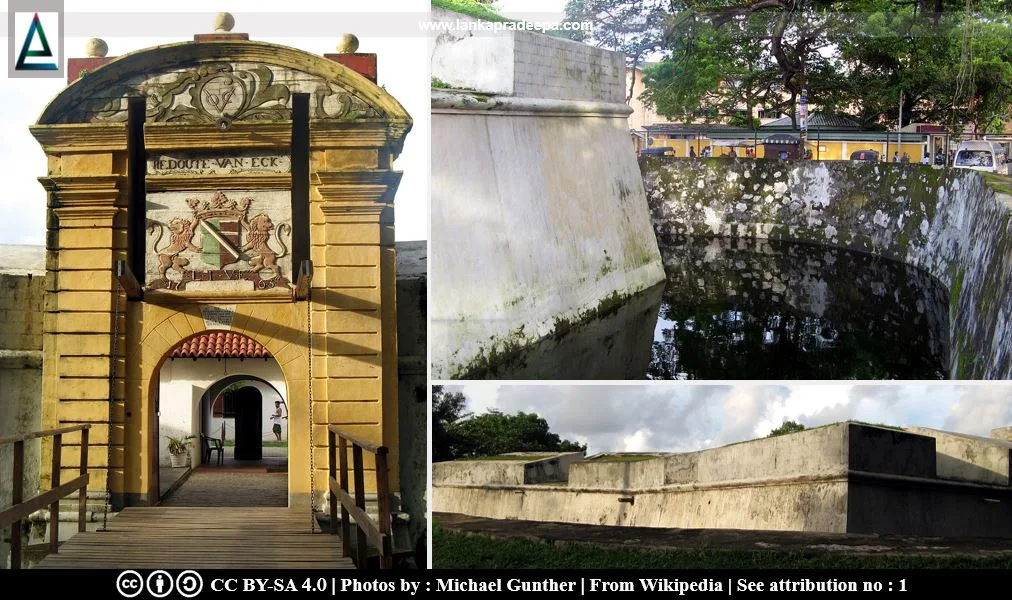
The Star Fort or Redoubt van Eck (Sinhala: මාතර තාරකා කොටුව; Tamil: விண்மீன் கோட்டை) is a Dutch fort situated in Matara District, Sri Lanka. Built on the western bank of the Nilwala Ganga River, the fort is located about 400 m from the entrance of the Matara Fort. It is the last major defensive work built by the Dutch in Sri Lanka (Abeyawardana, 2004; De Silva, 1988).
.
History
The Dutch who occupied several coastal parts of Sri Lanka after expelling the Portuguese gained control of the Matara Fort by the 17th century. In 1760 a rebellion took place at Matara mainly due to the Dutch endeavour to register peasants' holding of lands and either to dispossess or tax them if they couldn't prove title (De Silva, 1988). Sinhalese forces backed by the Kandyan Kingdom captured the Matara Fort in March 1761 and held it for a period of nearly one year (De Silva, 1988; Wikramaratne, 2015). The Dutch retook the fort in February 1762 and decided to erect the Star Fort on the western bank of the Nilwala Ganga River in order to strengthen their defences (De Silva, 1988; Wikramaratne, 2015).The construction work of the Star Fort was begun in 1763 and completed in 1765 (Abeyawardana, 2004; Mandawala, 2012; Wikramaratne, 2015). A person named Orukema Muhandiram was in charge of this construction under the Dutch Governor Baron Van Eck (Mandawala, 2012; Wikramaratne, 2015). After the fort was built, it was used as barracks with the residential accommodation for the Commanding Officer.
In 1796, the fort was fallen under the rule of the British (Abeyawardana, 2004; Wikramaratne, 2015). During their time, the fort was used as a residence for government officials and maintained under the Public Works Department (Abeyawardana, 2004; De Silva, 1988).
By 1965, the fort was the public library of Matara Urban Council (Abeyawardana, 2004; Wikramaratne, 2015). In 1980, it was taken over by the Department of Archaeology (Abeyawardana, 2004; Wikramaratne, 2015).
The fort
The fort has been built in the shape of a unique six-pointed star (Abeyawardana, 2004; De Silva, 1988; Wikramaratne, 2015). It is surrounded by a moat and a drawbridge with arches has been built at the main gate. Although the drawbridge no longer exists, the attractive gateway with the Dutch coat of arms is still well preserved (De Silva, 1988; Mandawala, 2012). The moat had been filled with earth but was later excavated and preserved by the Department of Archaeology (Abeyawardana, 2004). After the main gate, there are two similar gates and two inner rooms (Wikramaratne, 2015). A deep well is found in the middle of the fort (Wikramaratne, 2015).
The gate
The attractive arch-shaped entrance gate of Matara Star Fort is considered a splendid example of Dutch colonial architecture (De Silva, 1988). The semi-circular upper portion of it is ornamented with the VOC (Vereenigde Oostindische Compagnie: United East Indian Company) initials (De Silva, 1988; Wikramaratne, 2015). Below it is the name of the fort, Redoute van Eck (De Silva, 1988). A plaque with van Eck's coat of arms, flanked by two lions is found immediately below the fort name (De Silva, 1988). Also, the initials of van Eck (L.I.V.E.) and the year "1763" are denoted on the bottom of it (Wikramaratne, 2015).
Two long narrow slots into which the beams of the drawbridge (now vanished) retracted are found on either side of the upper half of the gate (De Silva, 1988).
Inscription
An inscription is found immediately above the arch-gate of the fort.
As De Ly, opperkoopman en secunde van het Gaals commant mitsd'. Dessave deser landen, AO MDCCLXV
A protected site
The Star Fort at Matara town (in Uyanwatta land located in the southern section of land plot no. 1 of the Mulika Pimbura no. 12875), in the Divisional Secretary’s Division
of Matara is an archaeological protected monument, declared by a
government gazette notification published on 26 March 1959.
Attribution
1) Dutch Star Fort, Matara 0689, Dutch Star Fort, Matara 0691, and Dutch Star Fort, Matara 0697 by G41rn8 (Michael Gunther) are licensed under CC BY-SA 4.0
References
1) Abeyawardana, H.A.P., 2004. Heritage of Ruhuna: Major natural, cultural
and historic sites. Colombo: The Central Bank of Sri Lanka. ISBN:
955-575-073-4. pp.67-68.
2) De Silva, R.R.K., 1988. Illustrations
and Views of Dutch Ceylon 1602-1796: A Comprehensive Work of Pictorial
Reference with Selected Eye-Witness Accounts. Brill Archive. pp.180-183.
3) Mandawala, P.B., 2012. Sri Lanka: Defending the military heritage;
legal, administrative and financial challenges. Defending the military
heritage; legal, financial, and administrative issues. Reports from the
Seminar 16 – 17 May, 2011, in Karlskrona, Sweden, organised by ICOMOS
International Scientific Committee for Legal, Financial and
Administrative Issues (ICLAFI) and the Swedish Fortifications Agency of
Sweden. p.101.
4) The Gazette of the Democratic Socialist Republic of Sri Lanka. No: 11709. 26 March 1959.
5) Wikramaratne, I., 2015. Pauranika Sthana Saha Smaraka: Matara Distrikkaya (In Sinhala). Department of Archaeology (Sri Lanka). ISBN: 955-9159-54-2. pp.59-60.
Location Map
This page was last updated on 30 April 2023

